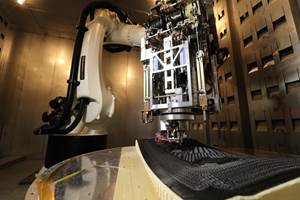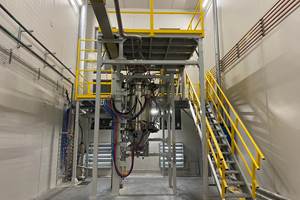Liqcreate Creates Flame Retardant Polymer for High Temperature Applications
Parts made with this additive manufacturing resin can withstand high temperatures without posing a fire hazard due to its self-extinguishing capabilities.
Dutch independent 3D printing material manufacturer Liqcreate has developed an engineering 3D printing resin called Liqcreate Flame Retardant HDT, which features high temperature resistance in combination with a UL94 V0 flammability rating. This rating is essential for a wide range of engineering, mobility, consumer goods and electronics applications.
The resin is an extremely rigid off-white photopolymer that can be processed on most resin-based 3D printers. The resin is compatible with digital light processing (DLP), liquid crystal display (LCD) and laser-based 3D printing systems operating in the range 385-420 nm. The 3D printing parameters for multiple printers can be found on the Liqcreate website.
Parts made with this resin can withstand high temperatures without posing a fire hazard due to its self-extinguishing capabilities. With an HDT-B value of 257°C / 495°F, it is well suite for high-temperature applications. Also, with its UL94 V0 rating, it is suitable for applications like interior parts in cars, airplanes, trains and electronic devices. In addition, it can be excellent for tooling manufacturing aids, connector housings and covers.
The below tables provide information regarding the mechanical properties of the Liqcreate Flame Retardant HDT:
Flame Retardant HDT Resin for Aviation and Mobility Applications
Liqcreate Flame Retardant HDT resin was tested by the UL94 organization and confirmed in their report that the product has the following flammability rating: UL94 V0 at 3mm. In addition, Liqcreate conducted an internal test method guided by the FAR 25.853 (Appendix F, Part I (a) (1) (ii)12 seconds Vertical Burn) testing methods which resulted in a pass at 1.5 mm thickness. These tests are a good basis for further development of applications within the aviation and mobility sector. Additional tests might be required to fully comply with the FAR 25.853 in aviation or the EN-45545 for train parts.
OEM Possibilities for Flame retardant 3D-Printing Resin
For OEM partners, the resin can be rebranded and optimized for different use cases and 3D printers. Alongside its branded resin range, Liqcreate also provides a custom development service, offering nonstandard formulas for specific applications. Through this service, customers can request the development of a polymer possessing precise characteristics, which impact its printing speed, as well as the properties of the resulting part.
As an independent resin manufacturer with R&D facilities, Liqcreate says it is capable of rapidly scaling its production of custom-made resins where needed. Moreover, the standalone nature of the company ensures there is minimal competition or conflict when working with 3D printer hardware manufacturers. This is said to ensure that the firm can work quickly, and get resins to market in quantity, avoiding any issues or delays that would keep clients waiting.
- Learn about a variety of polymers for additive manufacturing in our Polymer zone.
- Check out the latest advances in additive manufacturing for aerospace and automotive applications.
Related Content
How 3D Printing Will Change Composites Manufacturing
A Q&A with the editor-in-chief of CompositesWorld explores tooling, continuous fiber, hybrid processes, and the opportunities for smaller and more intricate composite parts.
Read MoreDrones Take Flight with Metal and Polymer 3D Printed Parts: The Cool Parts Show Bonus
Drones produced by Cobra Aero now incorporate many 3D printed parts made through laser powder bed fusion and Multi Jet Fusion processes.
Read MoreCan the U.S. Become Self-Sufficient in Aerospace Alloy Metal Powders?
6K’s technology can upcycle titanium and nickel-alloy parts into additive manufacturing powder. Here is how the circular economy helps national security.
Read MoreHow Norsk Titanium Is Scaling Up AM Production — and Employment — in New York State
New opportunities for part production via the company’s forging-like additive process are coming from the aerospace industry as well as a different sector, the semiconductor industry.
Read MoreRead Next
Looking to Secure the Supply Chain for Castings? Don't Overlook 3D Printed Sand Cores and Molds
Concerns about casting lead times and costs have many OEMs looking to 3D print parts directly in metal. But don’t overlook the advantages of 3D printed sand cores and molds applied for conventional metal casting, says Humtown leader.
Read MoreVideo: Intelligent Layering Metal 3D Printing at 3DEO
Contract manufacturer 3DEO delivers metal parts using Intelligent Layering, a binder jetting-like 3D printing process the company developed and operates internally. Here’s how it works.
Read More3D Printing Brings Sustainability, Accessibility to Glass Manufacturing
Australian startup Maple Glass Printing has developed a process for extruding glass into artwork, lab implements and architectural elements. Along the way, the company has also found more efficient ways of recycling this material.
Read More









.png;maxWidth=300;quality=90)















